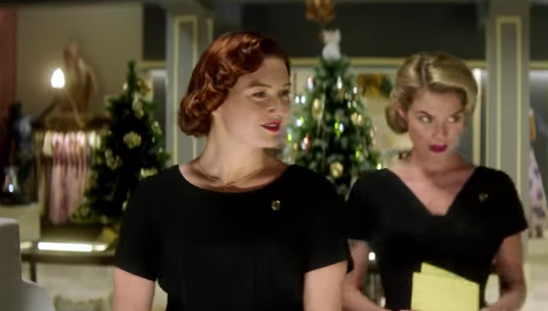
When Clive James showed director Bruce Beresford a novel by his friend Madeleine St John, The Women in Black, in London in 1993, neither men knew that St John’s simple tale of late-1950s Sydney life would not leave the film-maker in peace until he could finally realise his dream of a film adaptation twenty-five years later. James said the book “evoked the collision of modern European history and the still-awakening Australian culture”.
Joe Dolce writes on film in every edition of Quadrant.
Click here to subscribe
James and St John had known each other at Sydney University in 1959 when she had been a sub-editor on the university paper he edited, Honi Soit. James said, “I had absolutely no idea she was such a writing talent … she was a writer, a real one. But at that stage, she hadn’t written anything.” In the late 1960s they were both a part of the Australian expat community in London, along with Beresford, Barry Humphries, Germaine Greer, Peter Porter and Robert Hughes.
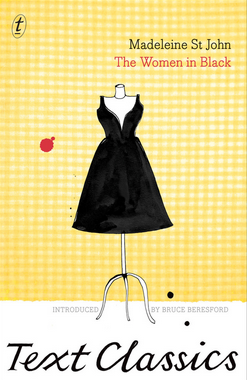 In 1957, John O’Grady, under the pseudonym of Nino Culotta, had published They’re a Weird Mob, about an Italian immigrant struggling to come to grips with the Australian language. It was an immediate best-seller, reprinted six times in the first six months.
In 1957, John O’Grady, under the pseudonym of Nino Culotta, had published They’re a Weird Mob, about an Italian immigrant struggling to come to grips with the Australian language. It was an immediate best-seller, reprinted six times in the first six months.
Ten years earlier, the Sydney-based anti-communist and pro-Catholic newspaper La Fiamma, founded by the Italian priest Giuseppe la Rosa, was launched, in part to oppose left-wing influence. By 1958, it had attracted a readership of 28,000.
Neil Young, reviewing Ladies in Black in the Hollywood Reporter, wrote:
Australia was at this point in the middle of a sustained economic boom and accompanying social changes, mirroring those elsewhere in the world. They are exemplified here by the emergence of a new, self-confident generation of young women and the parallel integration of post-WWII refugees from Europe.
Most migrants were employed in construction work but, in Melbourne and Sydney, high fashion was in its ascendancy. The Spanish designer Cristobal Balenciaga had introduced the pillbox hat, which became the hat of the 1950s and was made famous by Jackie Kennedy. The French designer Christian Dior brought the stiletto-heeled shoe to Australia.
In The Women in Black, a group of saleswomen, in a 1959 Sydney department store called Goodes (a fictional David Jones), wear the store’s distinctive black uniforms (“designed to flatter both the fuller and thinner figure, and truly enhanced neither”) and live according to fairly traditional Australian values of the time while around them the country deals with European immigration, the breakdown of class structures and the first seeds of women’s liberation.
A sixteen-year-old schoolgirl named Leslie Miles, who Beresford says is “unquestionably Madeleine St John herself” (played by Angourie Rice) has decided to change her name to Lisa, because she prefers a “real” girl’s name, and she becomes a temporary assistant at Goodes while awaiting her Leaving Certificate exam results. Her dream is to attend Sydney University and become a poet or an actress. Lisa comes from a working-class family and her father (played by Shane Jacobson) stubbornly tries to discourage her from pursuing higher education, referring to university as a “cesspit”.
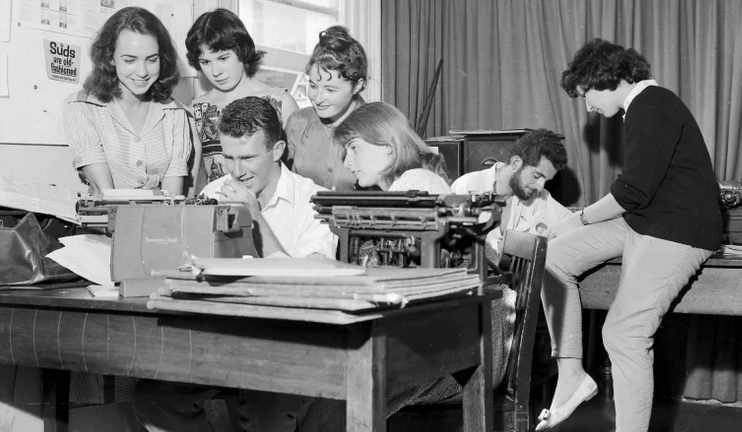
Madeleine St John (third from the left) watches a young Clive James help an issue of Honi Soit. (Photo: B. Newberry)
At Goodes, Lisa is introduced to “the luscious, the svelte, the full-bosomed” Magda Szombatheli (Julia Ormond), the immigrant Slovenian manager of Goodes’ upper level couture department, Model Gowns. The women on the lower floor, whispering under their breath, refer to Magda and her immigrant friends as “reffos” with “impossible surnames”.
Magda has a contemporary European vision for Australian fashion and decides to take the impressionable Lisa under her wing. Explaining the exclusivity of the dresses in Model Gowns, and their correspondingly high prices, she tells Lisa that “a woman who buys one of these frocks knows that she will not meet another wearing the same frock”, adding a playful dig at the traditional Sydney-Melbourne rivalry, “You might find it at George’s in Melbourne … who goes to Melbourne?”
When Lisa tries to explain this concept to her suburban mother (Susie Porter), her mother replies: “Well, no one else has the same clothes as you do either … because I make them, so they’re unique too, aren’t they?”
Amidst a cast of wonderful characters and several interlocking love stories, Lisa discovers a dress in Model Gowns, called “Lisette”, which she falls in love with but cannot afford, creating some of the key suspense of the story. Young writes:
The presence of the Hungarian-flavored influx of well-educated, culturally rich newcomers … provides Ladies in Black with a welcome depth that counterbalances the general air of brightly lit, excessively scored buoyancy which prevails. The status of refugees … has been a significant source of controversy in Australian public life … and is seldom far away from the headlines.
Bruce Beresford has left a mark on international cinema like few Australian directors. He co-wrote The Adventures of Barry McKenzie (1972) with Barry Humphries. Breaker Morant (1980) gained him an Oscar nomination. Tender Mercies (1983) won the Academy Award for its star, Robert Duvall, and Driving Miss Daisy (1989) starring Jessica Tandy and Morgan Freeman, won the Academy Award for Best Picture.
Isabella Rossellini had originally been on board to play the part of the exotic Magda in Ladies in Black, and later Monica Bellucci (with a prospective cast that also included Miranda Otto and Guy Pearce) but even with these stars, Beresford couldn’t secure the finance. One producer was keen but wanted to change the location to the US. Beresford refused. Milla Jovovich was offered the role of Magda, but declined as it conflicted with a higher-paid film she was considering, Future World.
Angourie Rice, who plays Lisa, starred in Spiderman: Homecoming and the 2017 remake of the 1971 Clint Eastwood film The Beguiled. Nicholas Hammond, who plays the concierge of Goodes, played Friedrich von Trapp in The Sound of Music (1965).
Key scenes were shot on the disused seventh floor of David Jones in Sydney, which had remained practically untouched since the late 1950s. By the time the producers discovered this rare and ideal location, they were told they had only limited time to shoot as the floor was due to be renovated.
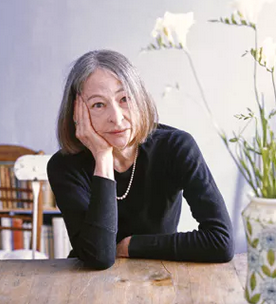 In his introduction to Madeleine: A Life of Madeleine St John, written by Helen Trinca, published by Text, which won the 2014 Prime Minister’s Literary Award for Non-Fiction, Beresford spoke of St John:
In his introduction to Madeleine: A Life of Madeleine St John, written by Helen Trinca, published by Text, which won the 2014 Prime Minister’s Literary Award for Non-Fiction, Beresford spoke of St John:
I remembered Madeleine (at right) as small and slight, with a mass of unkempt ginger hair and a sharp, sarcastic manner that kept me in awe and rather wary of her … The Women in Black immediately struck me as being the work of a modern-day Jane Austen, with all the wit and acute characterisations of that great writer.
Lisa Hill, in a review for the ANZ LitLovers blog, thought St John “more like Muriel Spark, because her wit is occasionally cruel”.
Madeleine St John was born in 1941, in Castlecrag, on the northern shore of Sydney, a suburb planned by Walter Burley Griffin. Her birth-name was Mireille, but she was always known as Madeleine.
Her father Ted St John was a second-year law student friend of Gough Whitlam and John Kerr and introduced her early to the works of Dickens and Shakespeare. The demanding hours required for her father to complete his law training contributed to her mother Sylvette’s depression and she became a heavy drinker and addicted to sedatives. Madeleine later spoke about it:
I think unconsciousness was what she was after. She is trapped, she can’t leave or she would be giving up her rights to the children. She is trapped in this situation, she can’t fight and she can’t flee. An animal in that situation would chew its leg off and I think that was what she was doing when she drank those dreadful potions—she was chewing her leg off.
After many unsuccessful suicide attempts, Sylvette finally killed herself when Madeleine was only twelve years old. Later Madeleine attended Sydney University and married Christopher Tillam, and they moved to San Francisco.
Her father, now a QC, had become a Liberal MP and in his 1967 maiden speech, said to be one of the most famous speeches in Australian political history, attacked his own party, criticising the “ineptness” of Prime Minister Holt over the Melbourne and Voyager collision. Two years later he denounced Prime Minister Gorton, calling him “a dangerous irresponsible playboy” and resigned from the Liberal Party. He remained in parliament as an independent until the 1969 election. In 1984 he collaborated with Les Murray on “The Universal Prayer for Peace: A Prayer for the Nuclear Age”.
In 1967, Madeleine travelled to England alone and decided to stay, effectively ending her marriage, which had not been going well. She never remarried.
Two years later, she took an overdose and was admitted to St Stephen’s asylum. When she was discharged, she worked for a time as a cleaning lady and was known as a meticulous housekeeper. She began to follow the Indian guru Swami-ji, and took therapy sessions with R.D. Laing, a Scottish psychiatrist who specialised in psychosis and was considered to be a key thinker of the New Left. Laing’s book The Politics of Experience, inspired by his experiments with LSD, became one of the handbooks for the early 1970s counter-culture.
St John had been writing a biography of Helena Blavatsky, the founder of Theosophy, struggling with it for many years, but with no success in securing a publisher she destroyed the manuscript and instead turned to fiction.
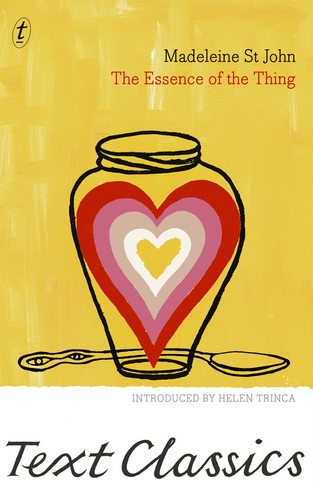 The Women in Black was her first novel and was published in 1993 by Andre Deutsch, London. The book was not successful but was admired by Clive James, who told Bruce Beresford about it. Beresford attempted to find finance for a film adaptation but was initially unsuccessful.
The Women in Black was her first novel and was published in 1993 by Andre Deutsch, London. The book was not successful but was admired by Clive James, who told Bruce Beresford about it. Beresford attempted to find finance for a film adaptation but was initially unsuccessful.
St John’s third novel, The Essence of the Thing, came to the attention of the 1997 Booker Prize judges during the qualifying year and they called for it to be considered, even though it had not been submitted by her publisher. She was shortlisted for the Booker, becoming the first Australian woman to achieve this distinction, but lost to Arundhati Roy’s The God of Small Things. The English press was not particularly kind to the book, the Daily Telegraph calling it “the last word in banality” and the Sunday Times: “tripe … grotesquely inane”.
St John once remarked: “Being religious is like being a writer: either you’ve got it or you haven’t.” Helen Trinca said: “Religion was important to Madeleine … she was interested in living a moral life in a secular age … Faith is applauded, not denigrated, in her novels.”
In her later years St John became a recluse. A heavy smoker of Golden Virginia and unfiltered Gauloises all her life, she died of emphysema in 2006, aged sixty-four, at St Mary’s Hospital in London. In her will, she named Beresford as her literary executor.
Text reissued The Women in Black in 2009. The pop musician Tim Finn read it and in 2015 contacted Beresford about composing a stage musical based on the novel, but retitled Ladies in Black. Believing that his long-hoped-for film of the book would never be made, Beresford granted permission.

There were good commercial reasons for the title change. Susan Hill’s 1983 horror novel The Woman in Black had been a best-seller and had been made into a play and a film. A title change may have avoided confusion and potential copyright issues. The first image that came to my mind of “women in black” was the tradition of Sicilian women wearing black for mourning. Beresford told me in an interview that they were also concerned with contemporary associations with female suicide bombers.
I don’t think St John would have approved of the change. The ground-breaking feminist work The Women’s Room had been published by Marilyn French in 1977, and one of French’s avowed objectives was to redress what she considered an imbalance between the way men and women were represented in popular culture. She took a simple difference in language used to identify the sexes in public toilets—the men’s room and the ladies’ room—to her, the latter now became the women’s room.
Although St John wasn’t strictly a feminist, she would have been aware of French’s popular work, and possibly her ideas. She certainly knew what she was doing when she chose her title. I believe she would have also struggled with Finn’s lyrics.
Tim Finn is best known for his pop band Split Enz. His musical, Ladies in Black, had an initial successful season in Brisbane, winning the 2016 Helpmann Award for best new Australian work, and was restaged that year in Melbourne, and again in 2017.
The reviews were mixed. The Age called it: “a unicorn of the stage: a full-blown, home-grown musical that actually works … probably the best Aussie musical since Priscilla went global”. But Ben Neutze of the Daily Review said it was “sweetly bland at its best and inept at its worst”, with most of his negative criticism targeted at the song-lyrics:
The vast majority of the lyrics are either clunky, blunt or banal. The show features far too many overworked or dreadful rhymes (no, rhyming “bastard” with “custard” isn’t a decent punchline), instances of emotionally repressed characters simply baldly declaring their feelings, and moments in which the musical emphasis falls on an inappropriate lyric.
The language often jars, in contrast with the sharp and subtle period dialogue of the novel. Finn would have been better served using St John’s actual words and studying the Great American Songbook and the works of the brilliant composer-lyricists who mastered the art of writing for musicals in the early twentieth century.
Nevertheless, the film probably would never have been made if it hadn’t been for the musical which helped bring Beresford’s long-time dream to fruition. That—and the unexpected arrival of an angel. Beresford said:
In 2017, a phone call came from a vivacious young woman named Allanah Zitserman, who had emigrated from Russia to Australia with her family as a child. She was captivated, in particular, by the migrant theme in The Women in Black. She proceeded to focus her awesome energy into raising finance for the film—the script that Sue and I had written, not the musical adaptation.
One of the members of my extended family, now in her nineties, worked at David Jones during the 1950s. She and a few of her friends saw both the musical and the film. They all agreed that one detail omitted was that during the post-Christmas sales, women customers always wore their gloves and hats when they shopped!
Beresford kept the Ladies in Black title change, but, wisely, did not use the musical’s songs for the movie, as he wanted to stay faithful to the dialogue of the novel. He commissioned a song from Finn to play over the closing titles, the beautiful “Always Be Happy”. Finn had sent the recording to Beresford, with his thirteen-year-old daughter, Elliot, singing a guide vocal to demonstrate how the song could sound. Rather than record a new version with a professional singer, Beresford liked Elliot’s version so much he decided to use that.
Always Be Happy
Don’t lose your guiding light,
to the joys of the night,
don’t give up even when your heart is breaking.
How strange everything feels,
my life’s become real,
a work of art that’s mine for the making.
No matter what happens,
always be happy,
for a glorious day.
The innocence and yearning of this song are a poignant counterpoint to the real-life story of St John and her difficult childhood. “Always Be Happy” adds a sublime touch to this idealised depiction of how St John would have liked her childhood to be. It is a wonderful close, taking Beresford’s movie to another memorable level.
In her final years, St John carried an oxygen cylinder around with her everywhere she went, to relieve her emphysema. In the obituary for the Independent, Christopher Potter wrote:
She lived by a strict moral code, the rules of which were only truly clear to herself … the control and desire for anonymity were typical St John qualities. At her death, her always Spartan flat was found to have been even further denuded. An obviously brand-new address book contained the telephone numbers of only a handful of people.
Bruce Beresford’s Ladies in Black was released in cinemas last year and is now available on DVD.
 Sign In
Sign In 0 Items (
0 Items ( Search
Search







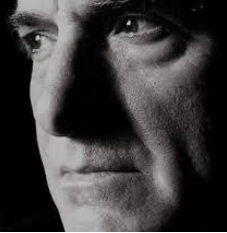


Usual feminist agitprop. The Sydney University educated gal complaining about the plight of women. Dad worked so hard to provide for the family that poor mum had to take to the drink. Give me a break. Greg Stone played the role of the father in the stage musical. I saw a good actor struggle to wade through yet another excruciatingly appalling depiction of a middle aged Australian male. It was like a scene from a comedia del Arte play, the audience could have easily booed or hissed his every utterance such was the paucity of thought. Is it any surprise that in this era of identity politics a work of this nature was nominated for a number of awards. Perhaps the father was prescient in his denunciation of higher education as a “cess pit” for surely that it what it has become. I thought Quadrant was a place to fight the prevalent leftoid cultural narrative, not a chance to join the chorus.